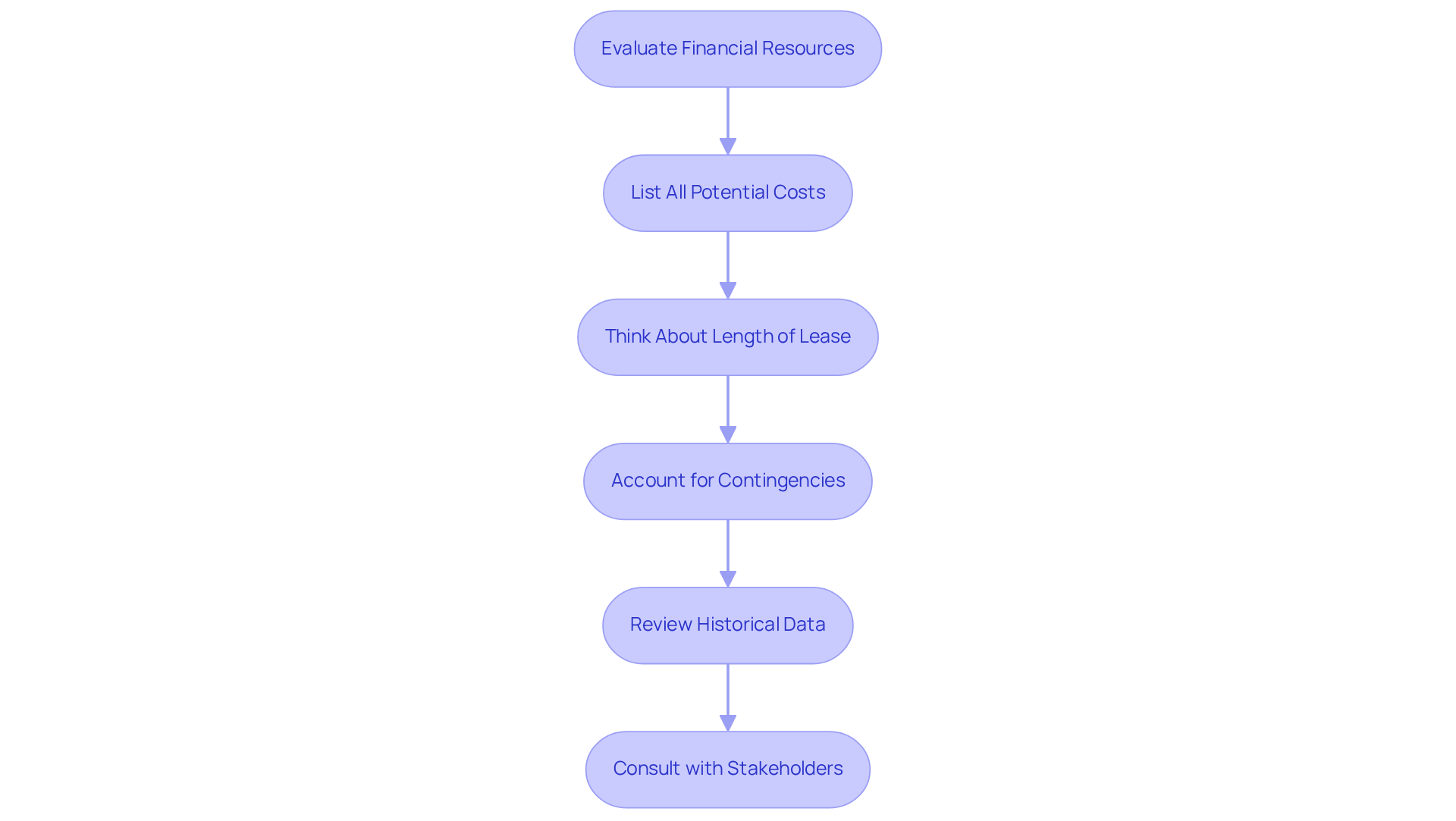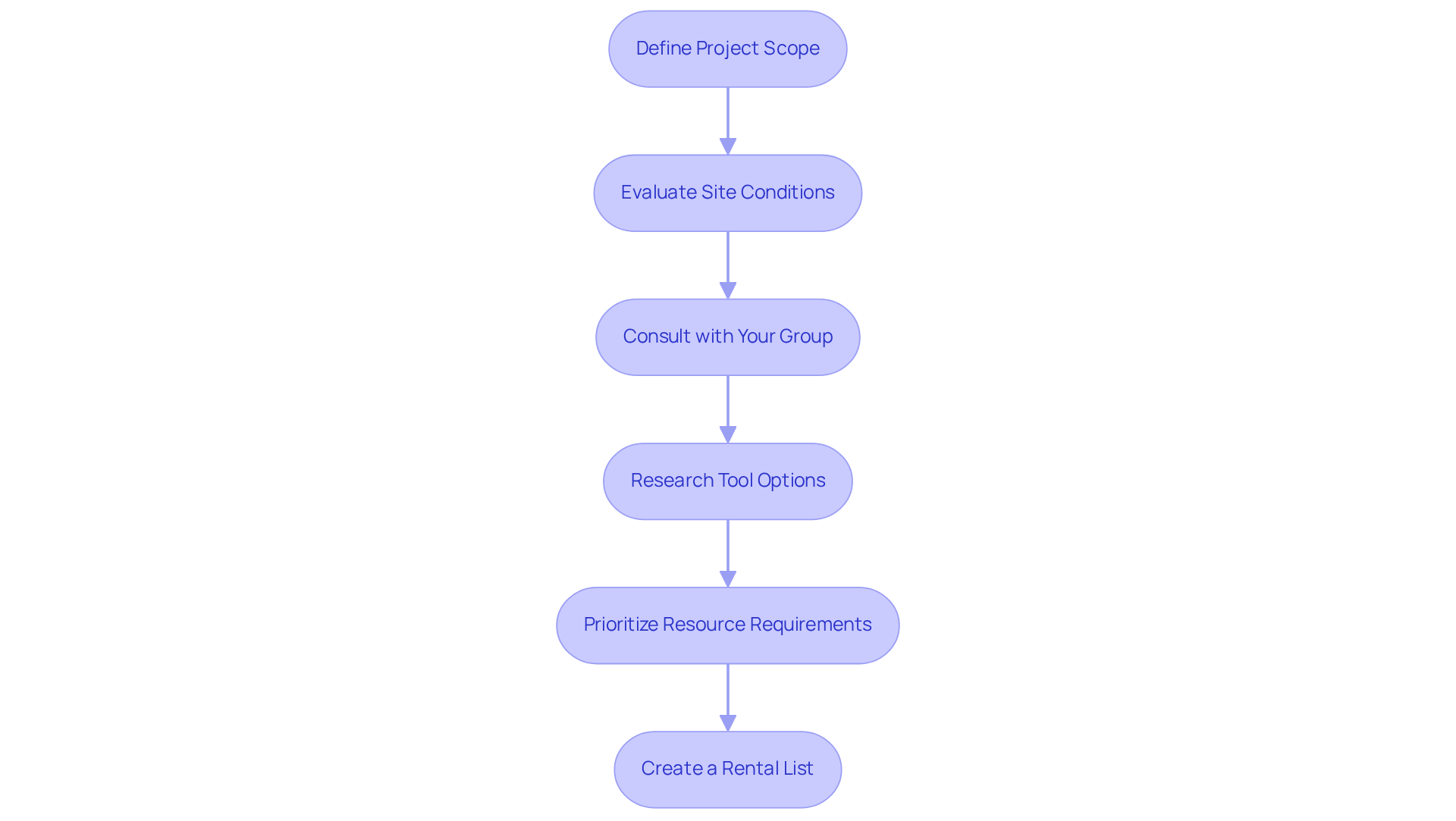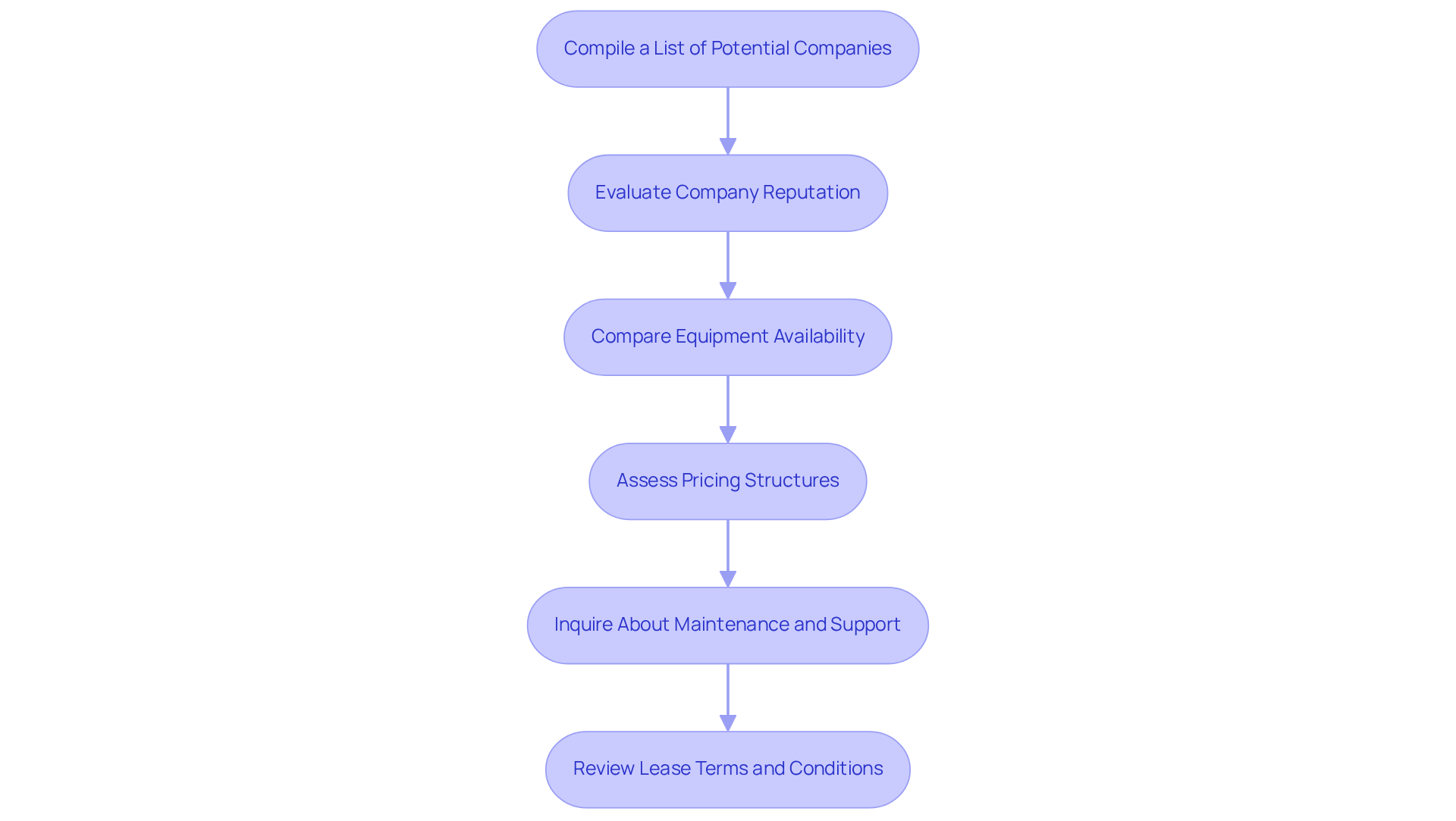Overview
To maximize an equipment rental budget, managers must:
- Assess their financial resources
- Compile all potential costs
- Prioritize equipment based on necessity
Engaging stakeholders for insights is crucial, as it fosters a collaborative environment that enhances decision-making. Furthermore, researching rental companies for competitive pricing ensures that managers secure the best possible deals. Accounting for contingencies is equally important, as it prepares organizations for unexpected expenses.
These essential steps contribute to informed financial planning and effective budget management, ultimately leading to successful project execution.
Key Highlights:
- Evaluate financial resources by identifying the overall budget, including leasing costs and related expenses.
- Compile a list of all potential costs associated with rentals, such as rental rates, delivery fees, and insurance.
- Consider the length of lease, as extended rentals may offer reduced rates and potential savings.
- Allocate 10-15% of the budget for unforeseen expenses to ensure flexibility.
- Review historical data to understand standard material expenses and usage trends for better financial planning.
- Engage with stakeholders to gather insights on resource needs and expenses for comprehensive financial planning.
- Define project scope to clarify requirements, as many construction firms are shifting towards ownership due to financial stability.
- Assess site conditions, including terrain and accessibility, to make informed equipment rental choices.
- Consult with team members for their preferences and experiences to enhance collaboration.
- Research available tools that meet project needs, considering specifications and compatibility.
- Prioritise equipment based on necessity and urgency to manage costs effectively.
- Compile a detailed rental list to guide communication with leasing firms.
- Compile a list of potential rental companies using online searches and recommendations.
- Evaluate company reputation through online reviews focusing on product quality and customer service.
- Compare equipment availability and request quotes from multiple companies to assess pricing structures.
- Inquire about maintenance practises and support services offered by rental companies.
- Review lease terms carefully to understand conditions and avoid potential disputes.
Introduction
Maximizing an equipment rental budget stands as a critical concern for managers dedicated to optimizing project efficiency while controlling costs. By implementing strategic steps, organizations can adeptly navigate the complexities of rental expenses, unlocking opportunities for significant savings. In addition, with fluctuating market trends and the imperative for precise resource allocation, managers must ensure they are making the most informed decisions regarding their equipment needs.
Furthermore, understanding the available services is essential. Each tool and equipment type offers unique benefits that can enhance operational effectiveness. For example, reliable machinery can reduce downtime, while quality equipment ensures projects are completed on schedule. By recognizing these advantages, managers can make choices that not only meet their immediate needs but also contribute to long-term success.
Ultimately, the call to action is clear: engage with reputable rental services that prioritize reliability and quality. By doing so, managers can confidently navigate the challenges of equipment rental, ensuring their projects are both efficient and cost-effective.
Understand Your Equipment Rental Budget
To effectively manage your equipment rental budget, it is essential to consider the following steps:
-
Evaluate Your Financial Resources: Start by identifying your overall budget for gear leasing. This should encompass not only the direct leasing costs but also related expenses such as transportation, insurance, and maintenance.
-
List All Potential Costs: Compile a comprehensive list of all potential costs associated with equipment rentals, including daily or weekly rental rates, delivery and pickup fees, fuel costs, maintenance and repair costs, insurance premiums, and additional fees such as late return charges.
-
Think About the Length of Lease: The duration of the lease significantly impacts your finances. Extended rentals often provide reduced rates, allowing for potential savings that can be reinvested into other areas. EZ Equipment Rental in Dallas offers competitive pricing options, making quality forklifts accessible and affordable for businesses of all sizes.
-
Account for Contingencies: Allocate a portion of your budget for unforeseen expenses, ideally 10-15% of the total budget. This ensures flexibility for emergencies or changes in scope.
-
Review Historical Data: Analyze previous initiatives to understand standard material expenses and usage trends. This knowledge can enhance your financial planning and set achievable expectations, particularly in light of recent fluctuations in material costs.
-
Consult with Stakeholders: Engage your team and stakeholders to gather insights on resource needs and potential expenses. Their contributions can help ensure your financial planning is comprehensive and aligned with your objectives.
By following these steps, you can develop a well-informed plan for renting equipment that aligns with your project goals while maximizing your equipment rental budget. In 2025, average rental costs in Texas are projected to remain stable, with only a slight increase expected. Therefore, it is crucial to stay updated on market trends to optimize your budget effectively.

Identify Your Equipment Needs
To effectively identify your equipment needs, follow these essential steps:
-
Define Project Scope: Clearly outline the project requirements, including tasks to be completed, timelines, and expected outcomes. This clarity is crucial, as 21% of construction firms intend to rent tools less often, indicating a shift towards ownership driven by financial stability and improved management.
-
Evaluate Site Conditions: Assess the physical conditions of the job site, considering factors such as terrain type (e.g., flat, hilly, rocky), accessibility for larger equipment, space constraints, and environmental conditions (e.g., weather, soil type). Understanding these elements significantly impacts equipment rental choices, as improper assessments can lead to delays and increased costs.
-
Consult with Your Group: Engage with your team to gather insights on their tool preferences and experiences. Their input is invaluable, especially since effective collaboration among contractors and designers is key to successful construction outcomes.
-
Research Tool Options: Investigate the types of tools available for rent that meet your project needs. At EZ Equipment Rental, discover a diverse selection of well-maintained tools, including forklifts, boom lifts, and excavators, tailored to your specific requirements. Consider equipment specifications (e.g., size, power, capacity), compatibility with other tools and machinery, and the availability of specialized attachments or accessories. This research is essential, as nearly 135,000 new pieces of construction equipment were financed in the U.S. in 2023, reflecting the dynamic nature of the market.
-
Prioritize Resource Requirements: Rank the identified tools based on necessity and urgency. Focus on essential tools first, and consider secondary options if the budget allows. This prioritization helps in managing costs effectively, particularly in maximizing equipment rental budget, as Benjamin Franklin warned that the bitterness of poor quality remains long after the sweetness of low price is forgotten.
-
Create a Rental List: Compile a list of the equipment you need, including quantities and specifications. This list will serve as a guide when reaching out to leasing firms, ensuring that you have a clear understanding of your requirements. EZ Equipment Rental is dedicated to delivering outstanding customer service and expert assistance to guarantee a smooth leasing experience in the DFW Metroplex.
By following these steps, you can ensure that you precisely identify your requirements, which is crucial for maximizing equipment rental budget, leading to more efficient project execution and better budget management.

Research Rental Companies
To effectively research rental companies, follow these essential steps:
-
Compile a List of Potential Companies: Begin by gathering a comprehensive list of rental firms in your area. Utilize online searches, industry directories, or recommendations from colleagues to identify viable options.
-
Evaluate Company Reputation: Investigate online reviews and ratings for each company. Focus on feedback regarding product quality, customer service, and reliability. Platforms like Yelp and Google Reviews provide valuable insights into customer experiences.
-
Compare Equipment Availability: Confirm that the companies you are considering have the specific equipment you need in stock. Reach out to them directly to inquire about availability and any forthcoming leasing schedules, as this can significantly impact your project timeline.
-
Assess Pricing Structures: Request quotes from multiple companies to compare leasing rates. Be vigilant about additional fees that may apply, such as delivery charges or insurance costs, as they can affect maximizing your equipment rental budget.
-
Inquire About Maintenance and Support: Ask about the maintenance practices of the leasing company. A reputable firm like EZ Equipment Rental ensures that their machinery, including forklifts, undergoes regular maintenance to minimize the risk of breakdowns during critical operations. Furthermore, inquire about support services in case of equipment failure during your usage period, as this can save you both time and money.
-
Review Lease Terms and Conditions: Carefully read the agreements to understand the terms, including duration, return policies, and liability clauses. Ensure that you are comfortable with the terms before proceeding, as this will help avoid potential disputes later.
By following these steps, you can select a trustworthy leasing firm that meets your requirements and financial plan, which is essential for maximizing equipment rental budget and ensuring a smoother experience. With the construction equipment rental market projected to grow significantly, making informed decisions is crucial for maximizing equipment rental budget and overall productivity. As noted by industry experts, thorough research can reduce overall costs and enhance project outcomes.

Conclusion
Maximizing an equipment rental budget is essential for successful project execution, requiring a strategic approach that combines a thorough understanding of financial resources, meticulous planning, and diligent research. By adhering to these steps, managers can ensure that their equipment rental decisions align seamlessly with project goals while effectively controlling costs.
Evaluating financial resources, identifying potential costs, and engaging with stakeholders to gather insights are critical components of this process. Furthermore, understanding project requirements and researching rental companies are vital for making informed decisions. These strategies not only facilitate better budget management but also enhance overall project efficiency, leading to superior outcomes.
The importance of managing an equipment rental budget cannot be overstated. As the construction equipment rental market continues to evolve, staying informed and proactive in financial planning empowers managers to optimize their resources effectively. By embracing these practices, organizations can achieve better project outcomes and foster a more sustainable approach to equipment management.
Frequently Asked Questions
How can I effectively manage my equipment rental budget?
To manage your equipment rental budget, evaluate your financial resources, list all potential costs, consider the length of the lease, account for contingencies, review historical data, and consult with stakeholders.
What should I include when evaluating my financial resources for equipment rental?
Your overall budget for gear leasing should include direct leasing costs as well as related expenses such as transportation, insurance, and maintenance.
What types of costs should I list when planning for equipment rentals?
You should compile a list of costs including daily or weekly rental rates, delivery and pickup fees, fuel costs, maintenance and repair costs, insurance premiums, and additional fees like late return charges.
How does the length of the lease affect my budget?
The duration of the lease can significantly impact finances, as extended rentals often come with reduced rates, allowing for potential savings that can be reinvested into other areas.
Why is it important to account for contingencies in my budget?
Allocating a portion of your budget for unforeseen expenses (ideally 10-15% of the total budget) provides flexibility for emergencies or changes in project scope.
How can reviewing historical data help in budgeting for equipment rentals?
Analyzing previous initiatives can reveal standard material expenses and usage trends, which enhances financial planning and sets achievable expectations, especially with fluctuations in material costs.
Who should I consult when planning my equipment rental budget?
Engage your team and stakeholders to gather insights on resource needs and potential expenses, ensuring that your financial planning is comprehensive and aligned with your objectives.
What are the projected rental costs in Texas for 2025?
Average rental costs in Texas are projected to remain stable in 2025, with only a slight increase expected, making it important to stay updated on market trends for effective budget optimization.




